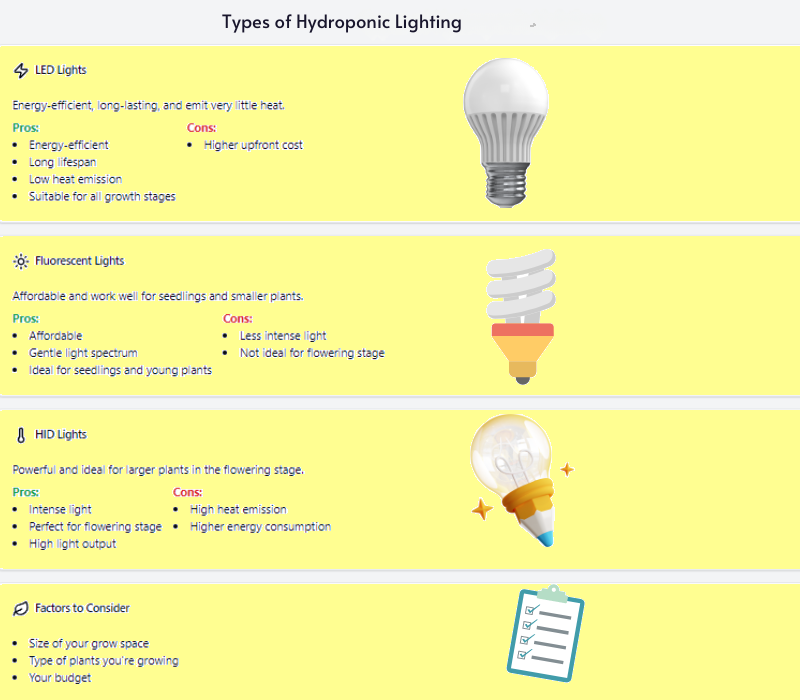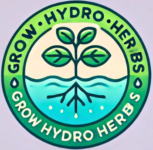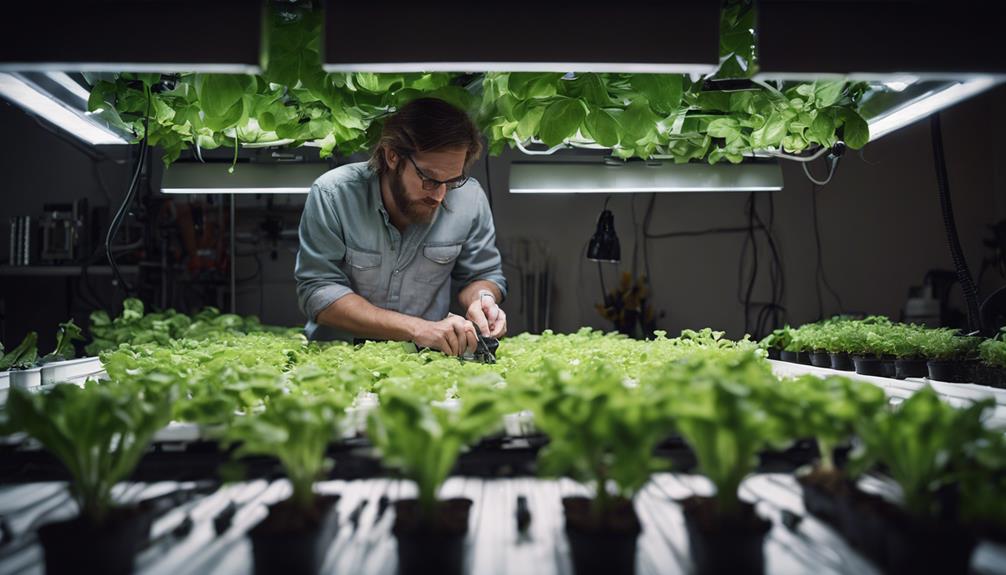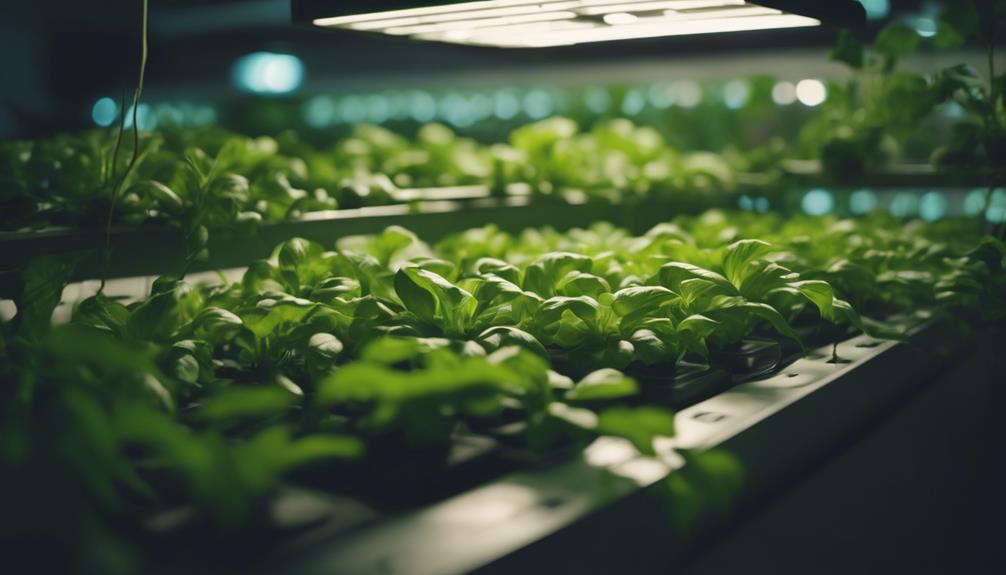Exploring the basics of hydroponic lighting is essential for successful indoor gardening. LED lights are energy-efficient and suitable for various growth stages. Fluorescent lights are affordable and ideal for seedlings. Each light type impacts plant growth differently. Consider plant type and budget when choosing lighting. Different light spectra influence photosynthesis and growth. Proper lighting enhances plant performance. Blue light aids in vegetative growth, while red light is vital for flowering. Light intensity should match plant needs. Position lights correctly for best distribution. Consistent light schedules are key. Keep monitoring light intensity to maintain ideal conditions.
GrowHydroHerbs TLDR
- Different lighting types (LED, HID, fluorescent) suit various growth stages.
- Light spectrum impacts photosynthesis, growth, and plant development.
- Proper light intensity and duration are crucial for optimal growth.
- Position lights at recommended distances for even light distribution.
- Consistent light schedule and monitoring ensure healthy plant growth.
Types of Hydroponic Lighting

Let’s set up your hydroponic system for proper lighting. First, you’ll need to choose from various types of hydroponic lighting. This will allow you to provide the necessary light for your plants.
The most common types of hydroponic lighting are:
- LED lights
- fluorescent lights
- high-intensity discharge (HID) lights.

LED lights are energy-efficient, long-lasting, and emit very little heat. This makes them a popular choice for hydroponic setups. Fluorescent lights, such as T5 and T8 bulbs, are affordable. They also work well for seedlings and smaller plants. HID lights are similar to metal halide and high-pressure sodium bulbs. They are powerful and ideal for larger plants in the flowering stage.
Each type of lighting has its advantages and is suited for different stages of plant growth. LED lights are great for all stages but can be pricier upfront.
Fluorescent lights are excellent for seedlings and young plants. This is due to their gentle light spectrum.
HID lights are perfect for plants in the flowering stage. That’s because they need intense light for blooming.
Be sure to consider the following when choosing the right hydroponic lighting for your setup:
- the size of your grow space
- the type of plants you’re growing
- your budget
Benefits of Proper Lighting

Proper lighting in your hydroponic setup is essential for your plants to thrive. By ensuring the right light spectrum, you can promote healthy growth and maximize productivity.
With proper lighting, you can enhance growth rates and ultimately increase your yield.
Light Spectrum Importance
Let’s understand the importance of light spectrum in hydroponic systems. If you do, you can optimize plant growth and overall yield. The light spectrum plays a vital role in the photosynthesis process of plants. It affects their growth and development. Here’s why it’s important:
- Enhanced Photosynthesis. Different light spectra have varying effects on plant photosynthesis. Providing the right spectrum can greatly boost the rate of photosynthesis. This leads to healthier and more robust plant growth.
- Improved Nutrient Absorption. Certain light spectra stimulate better absorption of essential nutrients by plants. This ensures they receive the necessary elements for best growth and development.
- Regulation of Plant Morphology. The light spectrum influences the shape, size, and structure of plants. By controlling the spectrum, you can guide the growth patterns of your plants. This results in more aesthetically pleasing and productive crops.
Understanding and utilizing the appropriate light spectrum for your hydroponic setup can make a substantial difference in the health and yield of your plants.
Growth Rate Enhancement
Maximize your plant’s growth rate by providing adequate and suitable lighting in your hydroponic system. Proper lighting plays an essential role in enhancing the growth rate of your plants. When your plants receive the right amount of light, they can photosynthesize efficiently, leading to increased growth rates.
By ensuring your plants receive the appropriate light intensity and spectrum, you can stimulate their growth and development. Light influences various physiological processes in plants, such as nutrient uptake, flowering, and overall plant health. With ideal lighting conditions, your plants can reach their full growth potential in a shorter amount of time.
Inadequate lighting can hinder your plant’s growth, causing them to become leggy, weak, or even fail to produce fruits or flowers. By providing sufficient lighting, you can promote strong and healthy growth, leading to higher yields and better overall plant performance in your hydroponic system.
Light Spectrum and Plant Growth

Now let’s talk about light spectrum and its impact on plant growth.
The essential wavelengths play a pivotal role in promoting healthy growth. Further, it also affects photosynthesis rates.
Let’s try to understand how different light spectrums can help you create an ideal environment for maximum growth.
Optimal Wavelengths for Growth
First, you want to ensure superior growth in hydroponic systems. To do so, understanding the relationship between light spectrum and plant growth is vital. Different wavelengths of light play a pivotal role in various stages of plant development.
- Blue Light: Assists with vegetative growth and promotes strong, healthy leaves. It also regulates plant morphology and enhances phototropism.
- Red Light: Vital for flowering and fruiting stages. Red light triggers photosynthesis and promotes the production of hormones responsible for flowering.
- Far-Red Light: Can be used to control flowering time and stem elongation. This makes far-red light a valuable tool for manipulating plant growth cycles.
Effects on Photosynthesis Rates
How do different light spectrums impact photosynthesis rates? Understanding this is essential for optimizing plant growth in hydroponic systems. The light spectrum plays a vital role in determining the rate of photosynthesis. This directly affects plant growth and development.
Different wavelengths of light have varying effects on photosynthesis. Blue light, for example, is essential for promoting vegetative growth. It has a shorter wavelength and is important for influencing leaf thickness, leaf size, and overall plant structure.
Red light, on the other hand, is critical for flowering and fruiting stages. It has a longer wavelength and helps regulate processes like flowering time and fruit development.
Choosing the Right Light Intensity

Consider the specific light requirements of the plants you’re growing when choosing the right light intensity for your hydroponic setup. The intensity of light greatly impacts plant growth and overall health.
Here are some key points to keep in mind when deciding on the appropriate light intensity for your hydroponic system:
- Plant Stage: Different growth stages require varying light intensities. Seedlings and young plants need lower light levels, while mature plants thrive under higher intensities.
- Light Spectrum: Make sure the light source provides a spectrum suitable for the plants you’re growing. Different plants have specific spectrum requirements for the best growth.
- Adjustability: Opt for lights that allow you to adjust the intensity. This feature is important as you can tailor the light level according to the plant’s needs throughout its growth cycle.
Setting Up Your Lighting System

What else do you need to do when setting up your lighting system for hydroponics?
First, make sure that you position the lights at the proper distance from the plants to optimize light distribution. Placing the lights too close can lead to light burn. Having them too far will result in insufficient light reaching the plants. Be sure to follow the manufacturer’s guidelines regarding the recommended distance based on the type of light you are using.
To help you better understand the ideal distance for your hydroponic lighting setup, refer to the table below:
| Type of Light | Recommended Distance from Plants |
|---|---|
| LED Lights | 12-24 inches |
| Fluorescent | 6-12 inches |
| HID Lights | 24-48 inches |
| CMH Lights | 18-36 inches |
Tips for Efficient Light Use

How does one maximize the efficiency of your hydroponic lighting system?
Make sure you adjust the light schedule according to the specific growth stage of your plants. This simple adjustment can greatly impact the growth and yield of your hydroponic garden.
Here are some tips to help you make the most of your lighting system:
- Consistency is Key: Maintain a consistent light schedule. This helps plants establish a healthy routine, promoting peak growth.
- Monitor Light Intensity: Regularly check the intensity of your lights. This will make sure they’re providing sufficient illumination for your plants’ needs.
- Consider Light Spectrum: Different growth stages require varying light spectrums. Research the ideal spectrum for each stage to enhance plant development effectively.
What Have We Learned About the Baics of Hydroponic Lighting?
Now that you have a better understanding of the basics of hydroponic lighting, you can confidently choose the right type of light, determine the best intensity, and set up your system for maximum efficiency.
Remember to take into account the light spectrum and its impact on plant growth, as well as implementing tips for effective light use.
With the right lighting in place, your hydroponic garden will thrive and produce healthy, vibrant plants.
Frequently Asked Questions
How Can I Prevent Light Burn on My Hydroponic Plants?
To prevent light burn on your hydroponic plants, place lights at the right distance, adjust intensity as needed, maintain proper ventilation, and monitor plant reactions. Regularly check for signs of stress like wilting or leaf discoloration.
Are There Any Special Considerations for Flowering Plants Under Hydroponic Lighting?
When growing flowering plants under hydroponic lighting, make sure they receive the right spectrum of light for blooming. Adjust light intensity and duration to mimic natural sunlight cycles. Monitor for any signs of stress or light burn.
Can I Use Regular Household LED Bulbs for My Hydroponic Setup?
You can use regular household LED bulbs for your hydroponic setup, but they might not provide the specific light spectrum needed for ideal plant growth. Consider investing in grow lights designed for plants for better results.
What Are the Optimal Light Cycles for Different Types of Plants?
For different plants, ideal light cycles vary. Research light needs for specific plants. Generally, vegetables thrive with 14-16 hours of light daily. Flowering plants often do well with 12 hours. Adjust based on plant growth stage.
How Do I Troubleshoot Light-Related Issues Like Yellowing Leaves?
There are several techniques for troubleshooting lighting issues. For instance, if yellowing leaves occur, assess light intensity, duration, and distance. Adjust placement, cycle length, or type of light accordingly. Monitor plant response. Guarantee proper ventilation and temperature control. Seek advice if issues persist.


